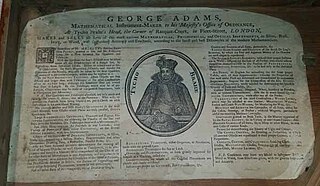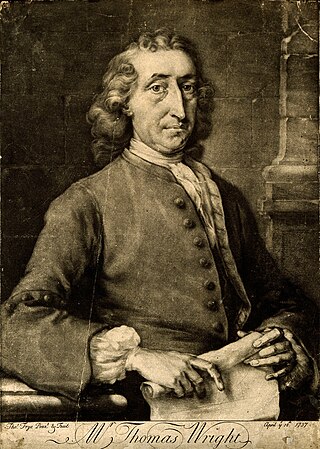Related Research Articles

George Adams was an English instrument maker and science writer. His son George Adams, who carried on the business, was also known as an instrument maker and optician.

William Oughtred, also Owtred, Uhtred, etc., was an English mathematician and Anglican clergyman. After John Napier discovered logarithms and Edmund Gunter created the logarithmic scales upon which slide rules are based, Oughtred was the first to use two such scales sliding by one another to perform direct multiplication and division. He is credited with inventing the slide rule in about 1622. He also introduced the "×" symbol for multiplication and the abbreviations "sin" and "cos" for the sine and cosine functions.

Jesse Ramsden FRS FRSE was a British mathematician, astronomical and scientific instrument maker. His reputation was built on the engraving and design of dividing engines which allowed high accuracy measurements of angles and lengths in instruments. He produced instruments for astronomy that were especially well known for maritime use where they were needed for the measurement of latitudes and for his surveying instruments which were widely used for cartography and land survey both across the British Empire and outside. An achromatic eyepiece that he invented for telescopes and microscopes continues to be known as the Ramsden eyepiece.

John Greaves was an English mathematician, astronomer and antiquarian.
Edmund Gunter, was an English clergyman, mathematician, geometer and astronomer of Welsh descent. He is best remembered for his mathematical contributions, which include the invention of the Gunter's chain, the Gunter's quadrant, and the Gunter's scale. In 1620, he invented the first successful analogue device which he developed to calculate logarithmic tangents.

The History of Science Museum in Broad Street, Oxford, England, holds a leading collection of scientific instruments from Middle Ages to the 19th century. The museum building is also known as the Old Ashmolean Building to distinguish it from the newer Ashmolean Museum building completed in 1894. The museum was built in 1683, and it is the world's oldest surviving purpose-built museum.

James Arthur Bennett, was a British museum curator and historian of science. Bennett's interests lay in the history of practical mathematics from the 16th century to the 18th century, scientific instruments and astronomy.

The Whipple Museum of the History of Science is a museum attached to the University of Cambridge, United Kingdom, which houses an extensive collection of scientific instruments, apparatus, models, pictures, prints, photographs, books and other material related to the history of science. It is located in the former Perse School on Free School Lane, and was founded in 1944, when Robert Whipple presented his collection of scientific instruments to the University of Cambridge. The museum's collection is 'designated' by the Museums, Libraries and Archives Council (MLA) as being of "national and international importance".

Cambridge Scientific Instrument Company was a company founded in the late 1870s by Robert Fulcher. The original use of the company was to service instruments for the Cambridge physiology department. In the beginning, the company was financially driven by a friend of Horace Darwin (1851–1928), Albert Dew-Smith (1848–1903). Eventually, Fulcher was fully replaced in the company by Darwin and Dew-Smith, in 1881, who would then become the sole co-owners. In light of the company being taken over, by Darwin and Dew-Smith, it grew in regard and size. By the time the company was about 15 years old, in 1891, Horace Darwin became the sole owner of the company.

A quadrant is an instrument used to measure angles up to 90°. Different versions of this instrument could be used to calculate various readings, such as longitude, latitude, and time of day. Its earliest recorded usage was in ancient India in Rigvedic times by Rishi Atri to observe a solar eclipse. It was then proposed by Ptolemy as a better kind of astrolabe. Several different variations of the instrument were later produced by medieval Muslim astronomers. Mural quadrants were important astronomical instruments in 18th-century European observatories, establishing a use for positional astronomy.
Henry Gregory (1744–1782) was an English mathematical and optical instrument maker. Gregory was apprenticed to John Fowler in 1732 and was himself in business from c. 1750–1792 from premises in Francis Court, Clerkenwell, London and an establishment known as "The Azimuth Compass" in Leadenhall Street, London. His company later became known as Gregory and Son.
Robert Stewart Whipple was a businessman in the British scientific instrument trade, a collector of science books and scientific instruments, and an author on their history. He amassed a unique collection of antique scientific instruments that he later donated to found the Whipple Museum of the History of Science in Cambridge in 1944.

Spencer, Browning & Rust was a London firm that manufactured instruments for navigational use during the 18th and 19th centuries. The predecessor company of Spencer and Browning was established by William Spencer and Samuel Browning in 1778, before they entered into partnership with Ebenezer Rust in 1784. After the death of Ebenezer Rust's son, the successor business was known as Spencer, Browning & Co. The firm of Spencer, Browning & Rust made a variety of navigational instruments, including octants and sextants.

William Spencer was an English mathematical instrument maker of the 18th and 19th centuries. Spencer entered into a partnership with Samuel Browning to form the company of Spencer & Browning after he apprenticed with instrument maker Richard Rust. When Ebenezer Rust joined the partnership, the resultant firm was known as Spencer, Browning & Rust. The company manufactured navigational instruments for both domestic and international markets.
Jonathan Sisson was an English instrument maker, the inventor of the modern theodolite with a sighting telescope for surveying, and a leading maker of astronomical instruments.
Samuel Knibb (1625–1674) was a clockmaker and instrument-maker.

John Cuff was an important English scientific instrument maker, particularly of microscopes.
William Forster was an English mathematician living in London, a pupil of the celebrated mathematician and astronomer clergyman William Oughtred (1574-1660). He is best known for his book, a translation and edition of Oughtred's treatise entitled The Circles of Proportion. Oughtred invented horizontal and circular forms of the slide rule, and Forster persuaded his master to let him translate his writings about their form and use, and to publish them. The publication resulted in a controversy, because another student of Oughtred's, Richard Delamain the elder, during the two years (1630-32) in which Forster was preparing the book, brought out two treatises on the same subject claiming the inventions as his own, and addressing himself to royal patronage. Forster's work was dedicated to that eminent intellectual, Sir Kenelm Digby (1603-1665), and the account of Oughtred's claim is found in Forster's Preface, or Letter of Dedication. Following the invention or discovery of logarithms by John Napier, in his Mirifici Logarithmorum Canonis Descriptio of 1614, the translation of that work by Edward Wright (1561-1615), and Henry Briggs's Arithmetica Logarithmica of 1624, the development of the slide rule had an important impact on the teaching of mathematics.
Euclid Speidell was an English customs official and mathematics teacher known for his writing on logarithms. Speidell published revised and expanded versions of texts by his father, John Speidell. He also published a book called Logarithmotechnia, or, The making of numbers called logarithms to twenty five places from a geometrical figure in 1688.

For other uses, see Thomas Wright (disambiguation).
References
- ↑ "Henry Sutton". Oxford Dictionary of National Biography (online ed.). Oxford University Press.(Subscription or UK public library membership required.)
- 1 2 Jardine, Boris (2008). "The 'incomparable' Mr. Sutton: a famous 17th-century instrument maker". Whipple Collections. Whipple Museum of History and Science. Retrieved 29 October 2016.
- ↑ "Henry Sutton Thinking: a Reading of a New Acquisition - Museum of the History of Science" . Retrieved 27 June 2016.